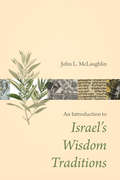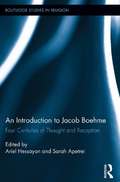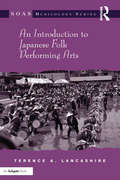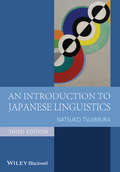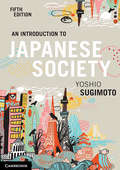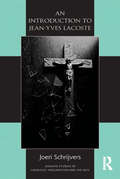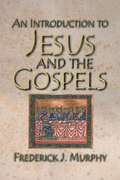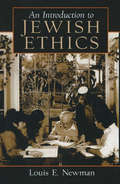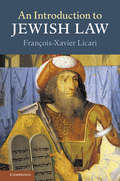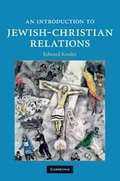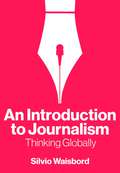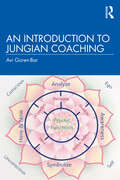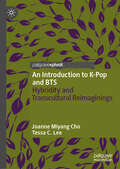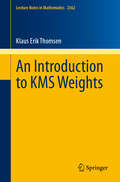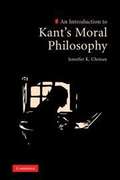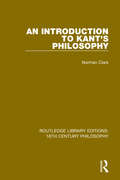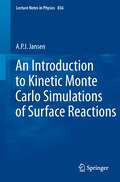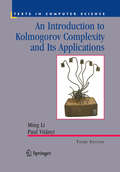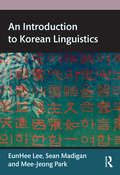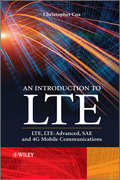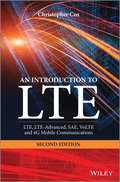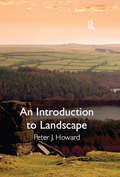- Table View
- List View
An Introduction to Israel's Wisdom Traditions
by John L. McLaughlinIt can be a challenge to understand the Hebrew Bible’s wisdom literature and how it relates to biblical history and theology, but John L. McLaughlin makes this complicated genre straightforward and accessible.This introductory-level textbook begins by explaining the meaning of wisdom to the Israelites and surrounding cultures before moving into the conventions of the genre and its poetic forms. The heart of the book examines Proverbs, Job, Qoheleth (Ecclesiastes), and the deuterocanonical Ben Sira and Wisdom of Solomon. McLaughlin also explores the influence of wisdom throughout the Old Testament and in the New Testament.Designed especially for beginning students—and based on twenty-five years of teaching Israel’s wisdom literature to university students—McLaughlin’s Introduction to Israel’s Wisdom Traditions provides an informed, panoramic view of wisdom literature’s place in the biblical canon.
An Introduction to Jacob Boehme: Four Centuries of Thought and Reception (Routledge Studies in Religion)
by Ariel Hessayon Sarah ApetreiThis volume brings together for the first time some of the world’s leading authorities on the German mystic Jacob Boehme, to illuminate his thought and its reception over four centuries for the benefit of students and advanced scholars alike. Boehme’s theosophical works have influenced Western culture in profound ways since their dissemination in the early 17th Century, and these interdisciplinary essays trace the social and cultural networks as well as the intellectual pathways involved in Boehme’s enduring impact. The chapters range from situating Boehme in the 16th Century Radical Reformation, to discussions of his significance in modern theology. They explore the major contexts for Boehme’s reception including the Pietist movement, Russian religious thought and Western esotericism, as well as focusing more closely on important readers: the religious radicals of the English Civil Wars and the later English Behmenists; literary figures such as Goethe and Blake, and great philosophers of the modern age, among them Schelling and Hegel. Together, the chapters illustrate the depth and variety of Boehme’s influence and a concluding chapter addresses directly an underlying theme of the volume – asking why Boehme matters today, and how readers in the present might be enriched by a fresh engagement with his apparently opaque and complex writings.
An Introduction to Japanese Folk Performing Arts (SOAS Studies in Music Series)
by Terence A. LancashireJapanese folk performing arts incorporate a body of entertainments that range from the ritual to the secular. They may be the ritual dances at Shinto shrines performed to summon and entertain deities; group dances to drive away disease-bearing spirits; or theatrical mime to portray the tenets of Buddhist teachings. These ritual entertainments can have histories of a thousand years or more and, with such histories, some have served as the inspiration for the urban entertainments of no, kabuki and bunraku puppetry. The flow of that inspiration, however, has not always been one way. Elements taken from these urban forms could also be used to enhance the appeal of ritual dance and drama. And, in time, these urban entertainments too came to be performed in rural or regional settings and today are similarly considered folk performing arts. Professor Terence Lancashire provides a valuable introductory guide to the major performance types as understood by Japanese scholars.
An Introduction to Japanese Kanji Calligraphy
by Bob Godin Takezaki KuniiThis step-by-step Japanese calligraphy book explains the systems of Japanese language and delves into details of written Japanese characters and techniques of kanji calligraphy.The word calligraphy literally means "beautiful writing." It is an art form that can be found in most civilizations with a written script. Originally developed to stress the importance of culture, religion and philosophy, over time calligraphy in most languages has developed into a purely artistic expression.In Japanese culture, kanji characters from the Japanese writing system are used in calligraphy. An Introduction to Japanese Kanji Calligraphy is an exploration of this Asian art form, and examines how calligraphic poetry developed in Japan. Written by a Japanese shodo master, it is a wonderful introduction to the beautiful art of Japanese calligraphy.Japanese Kanji Calligraphy includes:An introduction to Japanese calligraphy Background information on the modern Japanese language Hiragana and katakana charts An explanation of the tools of calligraphy A guide to correct calligraphy techniques Step-by-step calligraphy instructions An extensive kanji character library
An Introduction to Japanese Linguistics (Blackwell Textbooks in Linguistics)
by Natsuko TsujimuraThe third edition of this established textbook has been thoroughly updated and revised. It maintains its broad coverage of topics from phonetics to language variation, and increases its accessibility by incorporating a more descriptive, less theoretical approach. A fully updated new edition of this successful textbook introducing students to a wide range of issues, phenomena, and terminology in Japanese linguistics Includes extensive revisions to the chapters on phonetics, syntax and phonology, and incorporates a less theoretical, more descriptive approach Features the author’s own data, examples and theoretical analyses throughout Offers an original approach by discussing first and/or second language acquisition within each chapter Includes exercises exploring descriptive and theoretical issues and reading lists which introduce students to the research literature, both of which have been updated in this new edition
An Introduction to Japanese Society
by Yoshio SugimotoEssential reading for students of Japanese society, An Introduction to Japanese Society now enters its third edition. Here, internationally renowned scholar, Yoshio Sugimoto, writes a sophisticated, yet highly readable and lucid text, using both English and Japanese sources to update and expand upon his original narrative. The book challenges the traditional notion that Japan comprises a uniform culture, and draws attention to its subcultural diversity and class competition. Covering all aspects of Japanese society, it includes chapters on class, geographical and generational variation, work, education, gender, minorities, popular culture and the establishment. This new edition features sections on: Japan's cultural capitalism; the decline of the conventional Japanese management model; the rise of the 'socially divided society' thesis; changes of government; the spread of manga, animation and Japan's popular culture overseas; and the expansion of civil society in Japan.
An Introduction to Japanese Society (Contemporary Japanese Society Ser.)
by Yoshio SugimotoAn Introduction to Japanese Society provides a highly readable introduction to Japanese society by internationally renowned scholar Yoshio Sugimoto. Taking a sociological approach, the text examines the multifaceted nature of contemporary Japanese society with chapters covering class, geographical and generational variation, work, education, gender, ethnicity, religion, popular culture, and the establishment. This edition begins with a new historical introduction placing the sociological analysis of contemporary Japan in context, and includes a new chapter on religion and belief systems. Comprehensively revised to include current research and statistics, the text covers changes to the labor market, evolving conceptions of family and gender, demographic shifts in an aging society, and the emergence of new social movements. Each chapter now contains illustrative case examples, research questions, recommended further readings and useful online resources. Written in a lively and engaging style, An Introduction to Japanese Society remains essential reading for all students of Japanese society.
An Introduction to Jean-Yves Lacoste (Routledge Studies in Theology, Imagination and the Arts)
by Joeri SchrijversIntroducing the thought of philosopher and theologian Jean-Yves Lacoste, this book provides an overview spanning Lacoste's earliest works on sacramentality to his latest work Etre en Danger (2011) in which Lacoste opens up the liturgical experience onto a spiritual experience of life. Schrijvers unfolds the logic of what Lacoste calls 'the liturgical experience' from its violent variety in Expérience et Absolu to the logic of love and love's possibility as it is developed in the later works. Throughout the book, the focus is on Lacoste's dialogue with Heidegger and through this his attempt to widen the scope of phenomenology to include the phenomenality of the divine.
An Introduction to Jesus and the Gospels 18183
by Frederick J. Murphy“Jesus and the Gospels” is one of the most popular religion courses at colleges, and it is required at many seminaries and divinity schools. This textbook, written by an award-winning educator, is designed for a semester-long course in both these settings. Moreover, it could be used as a supplementary text in courses on christology, the historical Jesus, New Testament literature, and the Bible.Murphy will provide an introduction to the gospels that does justice to the full range of modern critical methods and insights. He will discuss the implications of these methods for how we understand the nature of the gospels and how we can read them today. The chapters will sketch the portrait of Jesus that emerges from each gospel, and then examine the “canonical” view of Jesus by comparing and contrasting these pictures, as well as the ones that emerge from the non-canonical gospels and from the modern quest for the historical Jesus. Chapter list: Introduction, Theological and Historical Backgrounds; Chapter 1, What is a Gospel? Chapter 2, History of Critical Methods for Gospel Study; Chapter 3, The Gospel of Mark; Chapter 4, Q; Chapter 5, Matthew; Chapter 6, Luke; Chapter 7, John; Chapter 8, Other Gospels (Gospel of Thomas, Infancy Gospels, other Apocryphal Gospels); Chapter 8, Christian Interpretations of Jesus; Chapter 9, The Historical Jesus; Chapter 10, Conclusion; Glossary; Further Reading; Notes; Subject Index. (Charts, sidebars, illustrations, and maps.)
An Introduction to Jewish Ethics
by Louis NewmanFor courses in Religion, Judaism and Ethics. This text offers an overview of the Jewish ethical tradition as it has evolved from biblical times to the present. Provides an overview of the central beliefs of classical Judaism and the ways in which these frame traditional Jewish approaches to issues in ethics, both theoretical and practical.
An Introduction to Jewish Law
by François-Xavier LicariJewish law is a singular legal system that has been evolving for generations. Often conflated with Biblical law or Israeli law, Jewish law needs to be studied in its own right. An Introduction to Jewish Law expounds the general structure of Jewish law and presents the cardinal principles of this religious legal system. An introduction to modern Jewish law as it applies to the daily life of Jews around the world, this volume presents Jewish law in a way that answers all the questions that a student of comparative law would ask when encountering an unfamiliar legal system. Sources of Jewish law such as revelation, rabbinical and communal legislation, judicial decisions, and legal reasoning are defined and analyzed, and the authority of who decides what Jewish law is and why their decisions are binding is investigated.
An Introduction to Jewish-Christian Relations
by Edward KesslerRelations between Christians and Jews over the past two thousand years have been characterised to a great extent by mutual distrust and by Christian discrimination and violence against Jews. In recent decades, however, a new spirit of dialogue has been emerging, beginning with an awakening among Christians of the Jewish origins of Christianity, and encouraging scholars of both traditions to work together. An Introduction to Jewish-Christian Relations sheds fresh light on this ongoing interfaith encounter, exploring key writings and themes in Jewish-Christian history, from the Jewish context of the New Testament to major events of modern times, including the rise of ecumenism, the horrors of the Holocaust, and the creation of the state of Israel. This accessible theological and historical study also touches on numerous related areas such as Jewish and interfaith studies, philosophy, sociology, cultural studies, international relations and the political sciences.
An Introduction to Journalism: Thinking Globally
by Silvio WaisbordJournalism remains a vital, irreplaceable institution in the public sphere, even though technology, political and economic trends, and globalization continue to impact it in negative ways.An Introduction to Journalism is the new go-to textbook for journalism studies. Organized around three thematic sections – structures, practices, and change and continuity – this textbook covers a broad range of issues central to the study of journalism. These include the nature of news as a socio-cultural construct; the impact of social forces (political, economic, technology, cultural) on journalistic practices and news content; the origin and the impact of journalistic norms, values, and ideologies; patterns of news access and consumption; the relation between journalism and public life; and the role of the press in democracy and authoritarianism. Taking a global perspective throughout, the textbook is grounded in the conviction that we need to examine developments across countries and regions, and understand how global forces shape news, journalism, and the news industry. Supported by extensive examples and clear case studies throughout, this accessible textbook, written by a leading scholar in the field, provides a comprehensive and analytical survey of the key themes that shape journalism. It is essential reading for undergraduate students of journalism studies.
An Introduction to Judaism
by Nicholas De LangeIn this new edition contemporary Judaism is presented in all its rich diversity, including both traditional and modern theologies as well as secular forms of Jewish identity. While the focus of the book is on developments that have taken place in the past two hundred years, they are set against a historical background, going back to the Bible. Beginning with a description of the Jewish people as it exists in today's world, it studies the unique concept of Jewish peoplehood and its survival over the centuries in the face of many challenges. An account of the key texts is followed by studies of the different interpretations of the religion, and the ways that life is lived out both in the home and in the community. Jewish theology is described both historically and in terms of contemporary issues. An important and distinctive section considers the goals of Jewish life and faith.
An Introduction to Jungian Coaching
by Avi Goren-BarBased on the psychology of Carl Jung, this illuminating new book invites coaches to extend their toolbox with deep, creative, and efficient professional methods that derive from a new perspective on coaching. In using the unconscious archetypes as a practical active psychological database for change, the Jungian coach can contribute significant modification in the coachee’s expected behavior. Jungian Coaching can be applied in evaluating the coachee, the team, and the corporation. This book translates Jungian psychology into simple comprehensive concepts. Each chapter translates theoretical concepts and rationale to thepractice of coaching. Illustrated with practical examples from the corporate world and life coaching, it offers Jungian Coaching tools and techniques. By integrating the Gestalt psychology principle of the "here and now" into Jungian concepts, the author develops a new coaching tool that enables an activation of archetypes as a useful and empowering coaching experience. A valuable introductory resource for all those involved in coaching relationships, this book can empower coachees and serve as a compass for personal growth. It will be of great interest to practicing coaches, executives, human resource managers, consultants, and psychotherapists.
An Introduction to K-Pop and BTS: Hybridity and Transcultural Reimaginings
by Joanne Miyang Cho Tessa C. LeeThis Palgrave Pivot examines a key area of the Korean Wave or Hallyu, which stands for the global popularity of South Korean popular culture that started in the 1990s. While K-dramas (Korean dramas) have found many viewers throughout Asian countries and some Western countries in recent years, K-pop (Korean popular music) has had broader appeal not only to Asian audiences, but also American (North and South), European, and Middle-Eastern audiences. This book&’s unique contribution is to provide a concise and succinct analysis of K-pop from transcultural perspectives through its most famous example, BTS. The first chapter contextualizes K-pop within the Korean Wave movement. The second and third chapters provide a history of K-Pop, spanning from Seo Taiji and Boys in the early 1990s to the present (including BTS and Blackpink), and presents K-pop as a glocalized phenomenon. The fourth, fifth, and sixth chapters critically examine the most prominent band in the K-pop world, BTS, and the unique connections to their transnational fandom called ARMY.
An Introduction to KMS Weights (Lecture Notes in Mathematics #2362)
by Klaus Erik ThomsenThis book provides an introduction to the theory of KMS weights and KMS states, which play an important role in mathematical physics and other applications of operator algebras. Leading from the definitions to some of the most recent research results, it covers advanced topics such as the Laca-Neshveyev theorem, elements of the modular theory of von Neumann algebras, the geometry of the set of KMS weights, duality (for KMS weights on crossed products), the relationship between KMS weights and traces and the types of factors associated with extremal KMS weights. Some of the material is new, in the sense that the proofs and results are published here for the first time. This relatively self-contained book will be useful both to researchers in the area of operator algebras and to more advanced students who wish to enter this field.
An Introduction to Kant'S Moral Philosophy
by Jennifer K. UlemanImmanuel Kant's moral philosophy is one of the most distinctive achievements of the European Enlightenment. At its heart lies what Kant called the 'strange thing': the free, rational, human will. This introduction explores the basis of Kant's anti-naturalist, secular, humanist vision of the human good. Moving from a sketch of the Kantian will, with all its component parts and attributes, to Kant's canonical arguments for his categorical imperative, this introduction shows why Kant thought his moral law the best summary expression of both his own philosophical work on morality and his readers' deepest shared convictions about the good. Kant's central tenets, key arguments, and core values are presented in an accessible and engaging way, making this book ideal for anyone eager to explore the fundamentals of Kant's moral philosophy.
An Introduction to Kant's Philosophy (Routledge Library Editions: 18th Century Philosophy #8)
by Norman ClarkEmmanuel Kant has the distinction of having introduced a great revolution into philosophy and yet stood the test of time. He stands as one of the great foundation stones of modern thought. This book, first published in 1925, covers Kant’s works essential to his philosophy as a system, and also illustrates his position in the history of thought. It is a clear and accurate statement of Kant’s chief doctrines.
An Introduction to Kinetic Monte Carlo Simulations of Surface Reactions (Lecture Notes in Physics #856)
by A.P.J. JansenKinetic Monte Carlo (kMC) simulations still represent a quite new area of research, with a rapidly growing number of publications. Broadly speaking, kMC can be applied to any system describable as a set of minima of a potential-energy surface, the evolution of which will then be regarded as hops from one minimum to a neighboring one. The hops in kMC are modeled as stochastic processes and the algorithms use random numbers to determine at which times the hops occur and to which neighboring minimum they go. Sometimes this approach is also called dynamic MC or Stochastic Simulation Algorithm, in particular when it is applied to solving macroscopic rate equations. This book has two objectives. First, it is a primer on the kMC method (predominantly using the lattice-gas model) and thus much of the book will also be useful for applications other than to surface reactions. Second, it is intended to teach the reader what can be learned from kMC simulations of surface reaction kinetics. With these goals in mind, the present text is conceived as a self-contained introduction for students and non-specialist researchers alike who are interested in entering the field and learning about the topic from scratch.
An Introduction to Kolmogorov Complexity and Its Applications (Texts in Computer Science)
by Ming Li Paul M. B. Vitányi"The book is outstanding and admirable in many respects. ... is necessary reading for all kinds of readers from undergraduate students to top authorities in the field." Journal of Symbolic Logic Written by two experts in the field, this is the only comprehensive and unified treatment of the central ideas and applications of Kolmogorov complexity. The book presents a thorough treatment of the subject with a wide range of illustrative applications. Such applications include the randomness of finite objects or infinite sequences, Martin-Loef tests for randomness, information theory, computational learning theory, the complexity of algorithms, and the thermodynamics of computing. It will be ideal for advanced undergraduate students, graduate students, and researchers in computer science, mathematics, cognitive sciences, philosophy, artificial intelligence, statistics, and physics. The book is self-contained in that it contains the basic requirements from mathematics and computer science. Included are also numerous problem sets, comments, source references, and hints to solutions of problems. New topics in this edition include Omega numbers, Kolmogorov-Loveland randomness, universal learning, communication complexity, Kolmogorov's random graphs, time-limited universal distribution, Shannon information and others.
An Introduction to Korean Linguistics
by Eunhee Lee Sean Madigan Mee-Jeong ParkAn Introduction to Korean Linguistics is a valuable and comprehensive text for those with an interest in Korean linguistics. This book provides an in-depth introduction to the basics of Korean linguistics, and modern linguistic theory, in an accessible style. It features a step-by-step approach designed to lead the reader through the linguistic make-up of the language, from the basics of its sound system and sentence structure to the semantics of modern spoken Korean. Features include: Detailed chapters covering the core areas in the field of linguistics, including phonetics, phonology, morphology and syntax Clear and accessible explanations which effectively demonstrate the intricacies and subtleties of the Korean language Suggested readings for those interested in expanding their knowledge of a specific topic Exercises designed to complement the factual and analytical issues covered in each chapter A comprehensive glossary of central terms and a companion website offering a wealth of additional materials. Korean is an invaluable language for the study of theoretical and comparative linguistics as it provides important examples and counter-examples to key issues, making An Introduction to Korean Linguistics an essential text for students and professional linguists alike.
An Introduction to LTE: LTE, LTE-Advanced, SAE and 4G Mobile Communications
by Christopher CoxAn Introduction to LTE explains the technology used by 3GPP Long Term Evolution. The book covers the whole of LTE, both the techniques used for radio communication between the base station and the mobile phone, and the techniques used for signalling communication and data transport in the evolved packet core. It avoids unnecessary detail, focussing instead on conveying a sound understanding of the entire system. The book is aimed at mobile telecommunication professionals, who want to understand what LTE is and how it works. It is invaluable for engineers who are working on LTE, notably those who are transferring from other technologies such as UMTS and cdma2000, those who are experts in one part of LTE but who want to understand the system as a whole, and those who are new to mobile telecommunications altogether. It is also relevant to those working in non technical roles, such as project managers, marketing executives and intellectual property consultants. On completing the book, the reader will have a clear understanding of LTE, and will be able to tackle the more specialised books and the 3GPP specifications with confidence. Key features - Covers the latest developments in release 10 of the 3GPP specifications, including the new capabilities of LTE-Advanced Includes references to individual sections of the 3GPP specifications, to help readers understand the principles of each topic before going to the specifications for more detailed information Requires no previous knowledge of mobile telecommunications, or of the mathematical techniques that LTE uses for radio transmission and reception
An Introduction to LTE: LTE, LTE-Advanced, SAE, VoLTE and 4G Mobile Communications
by Christopher CoxFollowing on from the successful first edition (March 2012), this book gives a clear explanation of what LTE does and how it works. The content is expressed at a systems level, offering readers the opportunity to grasp the key factors that make LTE the hot topic amongst vendors and operators across the globe. The book assumes no more than a basic knowledge of mobile telecommunication systems, and the reader is not expected to have any previous knowledge of the complex mathematical operations that underpin LTE. This second edition introduces new material for the current state of the industry, such as the new features of LTE in Releases 11 and 12, notably coordinated multipoint transmission and proximity services; the main short- and long-term solutions for LTE voice calls, namely circuit switched fallback and the IP multimedia subsystem; and the evolution and current state of the LTE market. It also extends some of the material from the first edition, such as inter-operation with other technologies such as GSM, UMTS, wireless local area networks and cdma2000; additional features of LTE Advanced, notably heterogeneous networks and traffic offloading; data transport in the evolved packet core; coverage and capacity estimation for LTE; and a more rigorous treatment of modulation, demodulation and OFDMA. The author breaks down the system into logical blocks, by initially introducing the architecture of LTE, explaining thetechniques used for radio transmission and reception and the overall operation of the system, and concluding with more specialized topics such as LTE voice calls and the later releases of the specifications. This methodical approach enables readers to move on to tackle the specifications and the more advanced texts with confidence.
An Introduction to Landscape
by Peter J. HowardInspiring deep emotion, landscape carries many meanings. This book follows the development of several threads of the concept of landscape as they have evolved across disciplines and across countries, leading to the European Landscape Convention and the designation of cultural landscapes as World Heritage Sites. The book introduces the key notions of landscape, such as landscape as meaning, as picture, as scale, as scenery and as place. It also considers the various factors which influence the way in which landscape is perceived now and in the past, with all of the senses. Finally, it looks of the various ways of protecting, managing and enhancing the landscape, taking into account a future of climate change. Beautifully illustrated and including 'capsules' in each section which provide fascinating insights into subjects from reading pictures, to mapping and GIS, through a discussion of the range of types of landscape to issues such as eco-museums, this book provides an excellent introductory overview for any students with an interest in the landscape around us.
